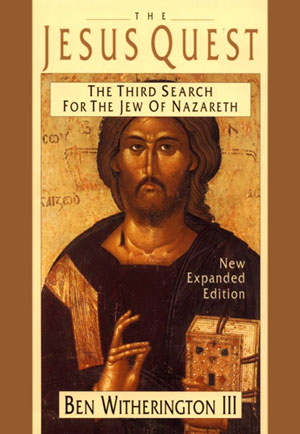| REVIEW: THE JESUS QUEST: THE THIRD SEARCH FOR THE JEW OF NAZARETH |
||
 by
Gary R. Habermas by
Gary R. HabermasOriginally published in Themelios (new series), v22. (Oct 1996): p. 61-62. The Reviewed Book Was Published by InterVarsity Press, 1995, 304 pp. This is an electronic copy of the entire article. The Jesus Quest: The Third Search for the Jew of
Nazareth
composition of the group and the claims they make for themselves, their criteria of authenticity, their confident use of non-canonical writings, and their general ignoring of the theological (and especially eschatological) nature of Jesus' teachings. Witherington summarizes: In particular, Jesus is denuded of his historical context, and his sayings are stripped of their literary settings' (p. 42). Later he amusingly concludes: 'We simply add that this seminar Jesus will not preach, did not. come to save and likely will not last1 (p. 57). Witherington is also hard on the somewhat related view that Jesus was a cynic philosopher [Chapter 3). He singles out. F. Gerald Downing [pp. 62 - 63) in a chapter that is otherwise chiefly concerned with the writings of John Dominic Crossan, critiquing several themes of the latter. Witherington comments about the cynic sage thesis that it 'dies with death of too many qualifications' (p. 72). While some contemporary approaches to the historical Jesus are rejected, others are thought to be more accurate. Throughout, one of Witherington's most frequent comments is that, many attempts provide partial pictures of Jesus (pp. 115, 142, 151. 160. ISO, 186, 232). He concludes that several emphases should be combined for the best representation (p. 185). The strengths of Witherington's text are many. It. takes pains to explain in detail the smorgasbord of attempts to interpret the historical Jesus, and does so quite readably. It covers a wide variety of both categories and commentators, offering very helpful endnotes that could easily serve as a basis for extended studies. Themelios readers will probably find few reasons to complain about this text, and most, objections would probably seem rather picky. It is true that (he first two quests arc relegated to less than four pages of the Preface. While it was not the author's intention to survey these movements in detail, a little more background would doubtless assist those without specific knowledge, especially where such would be very helpful in understanding current trends. For example, a relevant backdrop would enlighten the discussion of subjects like the various criteria commonly used in determining the authentic sayings of Jesus (pp. 46 - 48). Still, Witherington's work is the closest we have to the part played almost 100 years ago by Albert Schweitzer's classic The Quest of the: Historical Jesus. Though without the same amount of detail, this volume is still a worthy guide through the intricate research maze now known as the third quest for the historical Jesus. Gary R. Habermas, Liberty University Lynchburg, Virginia, USA p. 62 Citation Aid Footnote Entry: Gary R. Habermas, "Review: The Jesus Quest: The Third Search for the Jew of Nazareth," Themelios, ns 22 (Oct 1996): [page range cited]. Bibliography Entry: Habermas, Gary R. "Review: The Jesus Quest: The Third Search for the Jew of Nazareth." Themelios, ns 22 (Oct 1996): 61-62.
|
||
|